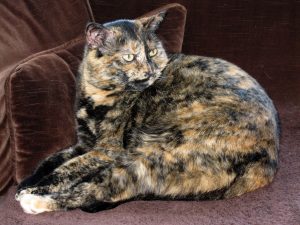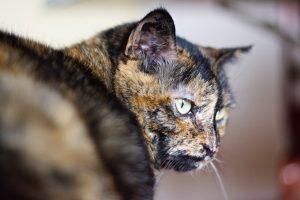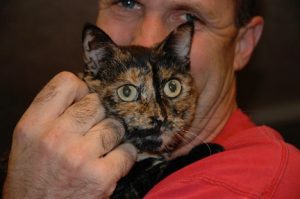
I first saw Hannah in one of the cat colony rooms at OHS. She was one of those cats who would find a dark and quiet corner so she could curl up and sleep all day. As the more active and playful cats around her got adopted, she continued to languish. Five months in, I couldn’t stand it anymore. I brought her home with me.
As it turns out, Hannah had a raging case of stomatitis, a painful inflammation of the mouth. Back in those days, OHS didn’t have a medical center like it does now, so her mouth disease was as yet untreated. The cure for stomatitis is extraction of any problem teeth. Days after her adoption, our veterinarian found that all of Hannah’s teeth except three canines needed to be removed. Once that was done, the process of healing both body and soul could begin.
Hannah was not the friendliest cat at first, but over time she decided she loved us after all. She would stretch out her chin for skritches and allow me to brush her endlessly. She’s the only cat I ever had that wasn’t mostly bonded to me: she reserved most of her love for my husband, Charles. This is his experience with our girl:
Building a Bond
I never considered myself to be a cat person. I always liked cats well enough, but never really formed close bonds with them. As an adult I never owned a cat—or more accurately, as I’d learn later, been “staff” to one. Cheryl brought Hannah home from one of her volunteer days at OHS about 10 years ago.

Hannah made it clear right away that she wasn’t likely to be a lovey-dovey sort of lap cat. She hated being picked up and would scamper away when a situation wasn’t to her liking. But she never went very far. When a safe distance away, she’d stop and look back. If you went about your business and didn’t get up in hers, soon enough, she’d be back in the room, up on a chair or at a safe distance, just watching.
We gave her space. She worked out her routine and we all went about our lives. Slowly, some slightly more social habits crept in. Like venturing into the living room and getting up on a fuzzy fleece blanket on the ottoman. If you tried to move her, she’d grumble and swish away, only to lurk and watch what you were doing.
She loved to drink from our water glasses: dip a paw in, lick it off, repeat. She liked to floss her three remaining teeth on the fireplace broom, and I’m sure we’ll be finding her teeth marks on cardboard boxes she gnawed on for years to come. For a while, she walked around the house with a pink Nerf ball in her mouth, merrily warbling away to her “baby.” Then she’d throw her baby down the basement stairs.
I could vacuum my office and she wasn’t in the least perturbed. I could run the vacuum right under the chair she was sitting on. She was no shrinking violet despite her quiet nature. She took on big dogs with attitude and verve. One day she decided to have a nap on my nice warm laptop and actually managed to send a garbled and indecipherable email to my confused mother. She was a cat of many talents.
Trust, Timing and Respect
As time passed, she figured out that we were for real and nothing was going to harm her. She began bonding with us, in her own, sometimes peculiar, ways—and always on her own terms. It was a delicate dance of trust, timing and respect. She began to like getting scratched under the chin and behind her ears. The brush wasn’t too bad either, but there were only certain places in the house where these activities could take place. That place was usually my office.

For several years there was a small brown couch in that room. I worked on my laptop at the desk, while she sat on the couch. Sometimes I’d read and we’d take up our respective sides of the couch and simply be. She liked to just be there, she didn’t need to be petted or cuddled.
When I remodeled my office and took out the couch, I replaced it with a row of cabinets that were at windowsill height. Cheryl made some padded blankets to go on the tops of the cabinets and the game of bird watching was on. I put feeders in the yard for the nutcrackers and hung a hummingbird feeder right in the window. Oh boy, that was entertainment. Warbling and chittering at the birds were on Hannah’s agenda now.
Maybe it was just Hannah’s nature, but I realized that her friendship had to be earned, one respectful day at a time. It was a slow and gradual process. Even if I broke her rules and overstepped a boundary, Hannah never acted out. Sometimes the dog would get a swat, but she usually had it coming. Eventually, I could see a change in the way Hannah watched the world. She was less wary and more interested. She’d approach me for affection, rather than my having to go to her. A long-dormant soft purr began to appear. It was enormously satisfying for me.

In time, Hannah turned into a creampuff, but still with a touch of attitude. She still didn’t like to be picked up or moved from a chair, but now I had a real pal. She would follow me from room to room, sit for hours with me and welcome any attention or affection I offered. Brushing sessions were high on her list of favorite activities.
Maybe it’s just my own maturing as I reluctantly slide into middle age, but I like to think Hannah helped me to be more patient of other people and situations out in the world. A hard-earned friendship can do that, and yes, I learned that sort of friendship can be with a cat.
Contributed by Cheryl Smith and Charles Freeborn, OHS Volunteers
Learn More
OHS has many adult cats available for adoption right now. Some may settle into their new homes quickly; others, like Hannah, might take more time to adjust. Thank you for considering an adult pet as well as the adorable young ones!
Find the right cat for you and come adopt at OHS »
Learn more about the adoption process at OHS »
Become a volunteer to help socialize and care for the animals »
Pet advice, training and help line »



